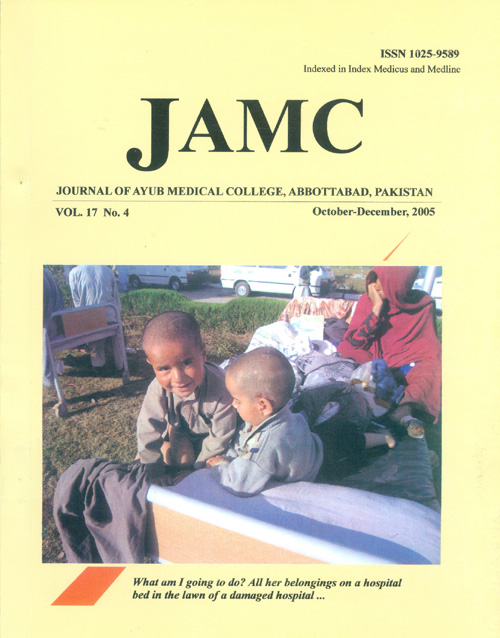SECRETION OF CALCIUM IN THE SALIVA OF LONG-TERM TOBACCO USERS
Abstract
Background: Secretion of calcium in saliva depends upon salivary flow rates in non-tobaccousers and greater is the rate, lower is the concentration and vice versa. In long-term tobacco usersthe taste receptors, a primary site for salivary secretion, are constantly exposed to tobacco for longtime thus presumably affecting the salivary reflex. Therefore the main purpose of the study was tostudy the secretion of calcium in the saliva of theses individuals. Methods: Subjects of the studywere divided into smokers, pan, (tobacco-betel-lime "quid") chewers, niswar (moist oral snuff)dippers and non-tobacco users as controls. Each group was comprised of 20 healthy male adults.The saliva of each subject was collected under resting condition and following application ofcrude nicotine and citric acid solutions to the tip of his tongue. Results: All groups of long-termtobacco users exhibited significantly higher concentrations of calcium before and after stimulationwhen compared with controls .However significant drop was observed in calcium levels of allgroups including controls after stimulation but this drop was more pronounced after stimulationwith citric acid than after stimulation with nicotine. Conclusion: We conclude that higher levelsof calcium are present in the saliva of long-term tobacco users than non users which decreases asthe flow of saliva increases.Key Words: Saliva, calcium, tobacco users.References
Tordoff MG. Calcium: Taste, Intake, and Appetite. Physiol
Rev 2001;81:1567-97
Larson PS, Haag HB, Silvette H. Tobacco, Experimental
and Clinical Studies. Baltimore, The Williams and Wilkins
Company,1961.
J Ayub Med Col Abbottabad 2005;17(4)
Reddy MS, Naik SR, Bagga OP, Chuttani, HK. Effect of
chronic tobacco-betel-lime “quid” chewing on human
salivary secretions. Am J Clin Nutr 1980;33:77-80.
Khan GJ, Mehmood R, Salah-ud-Din, Ihtesham-ul-Haq.
Effects of long-term use of tobacco on taste receptors and
salivary secretion. J Ayub Med Coll 2003;15(1):37-9.
Heintz U. Secretion rate, buffer effect and number of
lactobacilli and streptococcus mutans of whole saliva of
cigarette smokers and non-smokers. Scand J Dent Res
;1:294-301.
Parvinen T. Stimulated Salivary flow rate, pH and
lactobacillus and yeast concentrations in non-smokers and
smokers. Scand J Dent Res 1984;92:315-8.
Pavia DL, Lampman GM, Kriz Jr GS. Introduction to
Organic Laboratory Techniques. A Contemporary
Approach. W B Saunders Company. Philadelphia. 1976:46-
Burgen ASV. The secretion of potassium in saliva. J
Physiol 1956;132:20-39.
Jonhansson I, Ericson T, Steen L. Studies of the effect of
diet on saliva secretion and development and the effect of
fasting on the saliva composition of female subject. J Nutr
;114:2010-20.
Guyton AC, Hall JE. In:Textbook of Medical Physiology.
Harcourt A Health Sciences Company. Philadelphia. WB
Saunders and company. 2000: 738-53.
Ganong WF. Review of Medical Physiology. Appleton and
Lange. Medical Publishing Division. California. 1987:406-
Sewon L, Laine M, Karjalainen S, Doroguinskaia A,
Lehtonen-Veromaa M. Salivary calcium reflects skeletal
bone density of heavy smokers. Arch Oral Biol
;49(5):355-8
Issue
Section
License
Journal of Ayub Medical College, Abbottabad is an OPEN ACCESS JOURNAL which means that all content is FREELY available without charge to all users whether registered with the journal or not. The work published by J Ayub Med Coll Abbottabad is licensed and distributed under the creative commons License CC BY ND Attribution-NoDerivs. Material printed in this journal is OPEN to access, and are FREE for use in academic and research work with proper citation. J Ayub Med Coll Abbottabad accepts only original material for publication with the understanding that except for abstracts, no part of the data has been published or will be submitted for publication elsewhere before appearing in J Ayub Med Coll Abbottabad. The Editorial Board of J Ayub Med Coll Abbottabad makes every effort to ensure the accuracy and authenticity of material printed in J Ayub Med Coll Abbottabad. However, conclusions and statements expressed are views of the authors and do not reflect the opinion/policy of J Ayub Med Coll Abbottabad or the Editorial Board.
USERS are allowed to read, download, copy, distribute, print, search, or link to the full texts of the articles, or use them for any other lawful purpose, without asking prior permission from the publisher or the author. This is in accordance with the BOAI definition of open access.
AUTHORS retain the rights of free downloading/unlimited e-print of full text and sharing/disseminating the article without any restriction, by any means including twitter, scholarly collaboration networks such as ResearchGate, Academia.eu, and social media sites such as Twitter, LinkedIn, Google Scholar and any other professional or academic networking site.









